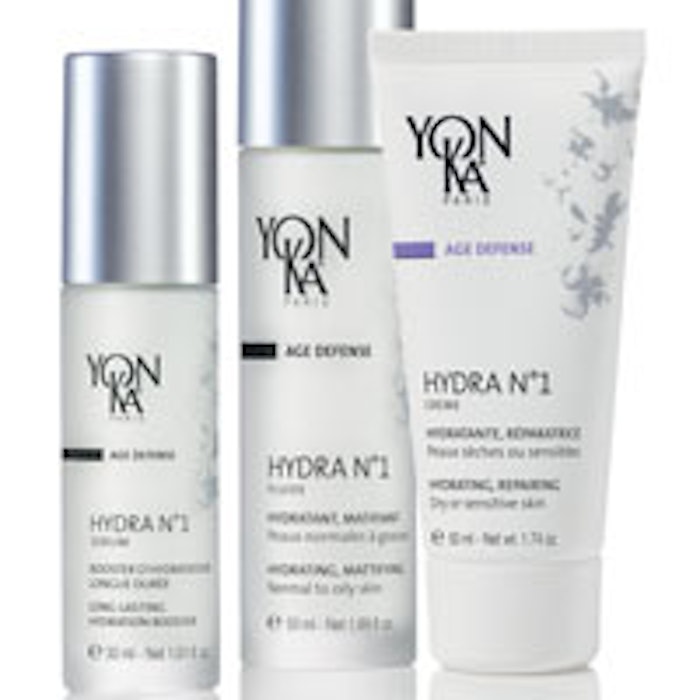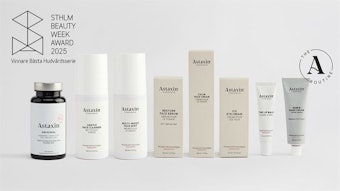
Clean and crisp … unique and remarkable … essential. These are a few of the words and phrases that came to me when I set out to write about water, and the impact it has on the health and beauty of the skin. Considering the average adult is comprised of approximately 70% water, it’s no surprise that without it, you can’t survive. Capable of keeping skin vibrant and voluminous, water is asessential to all layers of skin as it is for the basic processes of life.
The epidermis holds large amounts of water and is built just like a brick wall, with the keratinocytes of the epidermis acting as bricks and the mortar represented by intercellular cement. Water is first held in the cytoplasmic gel and the intercellular channels. Intercellular cement is formed when cells transform and keratinize, thus releasing their moisture and trapping it between the cellular spaces. Balanced amounts of intercellular cement keeps the epidermis hydrated and in balance due to its ability to both attract moisture and limit its evaporation.
Another function of the intercellular cement is to “waterproof” the skin and prohibit the entrance of exterior moisture into the skin. This would explain why it is not possible to moisturize the skin simply by applying water to it.
During the aging process, cells begin to shrink, flatten and lose contents of the cytoplasm, thus limiting the amount of intercellular cement and hydrating actions. The sublayer with the highest water content is the germinative layer (basal cell layer) at about 80%; and each subsequent layer has less natural moisture content. For example, the stratum corneum’s moisture content drops to just 10-15% water.
The natural moisturizing factor (NMF) of the skin refers to its mechanism of self-hydration. Conceptually, it consists of vital fluids intertwined within the intercellular cement. The evaporation of the NMF of the skin is known as transepidermal water loss (TEWL). In this way, the lower the NMF of the skin, the lesser the ability of the skin to retain vital moisture, allowing the greater rate of evaporation of this moisture, equaling an increased rate of TEWL and dehydration.
Healthy skin function also relies on adequate amounts of hydrolipidic film. A natural emulsion, hydrolipidic film is meant to protect the stratum corneum by ensuring cellular cohesion and flexibility. Without the two primary barriers of hydrolipidic film and intercellular cement, the skin would lose its ability to retain water and would become tight, rough, lackluster, and marked by dehydration lines.
Dry vs. dehydrated skin: What’s the difference?
Affecting 90% of the population, dehydrated skin lacks sufficient water content, yet it may still produce oil. Dehydration may be either superficial or deep, and static (permanent) wrinkles are a consequence of deep dehydration of the skin.
The affect of even mild dehydration is compounded and can hasten the overall aging process of the skin, especially if powerful and long-lasting hydrating products are missing from the daily regimen. In fact, many people frequently spend their days in a state of mild overall dehydration. Dry skin, as a skin type, is alipidic skin that is not producing enough natural sebum, the oily protective secretion of the skin's sebaceous glands. Through visual analysis, dry skin will typically display small or barely visible pores, resulting from an underutilization of the pilosebaceous unit, which isn’t processing the same adequate amounts of sebum that normal skin would.
Dry and aging skin frequently displays the most severe dehydration, which is also displaying decreased intercellular cement and NMF, beginning a vicious cycle of heightened dehydration, increased sensitivity and inflamed skin. This means the severity of the skin's dryness can also impact the extent of its dehydration.
Now that the causes of dehydration are understood from a cellular perspective, advancements in botanical science offers long-term defense against dehydration. YON-KA Paris recently completed the launch of HYDRA N◦1 Collection, which is a complete program of products with powerful and long-lasting hydrating benefits based on three tenets.
1. Time-released hydrating action. The osmo-regulating ingredient responsible for the time-released action is Imperata cylindrica, a subtropical type of grass indigenous to desert areas with intensive water-trapping and preserving capabilities. This extract also has high starch, potassium and 3-dimethylsulfoniopropionate, which preserves cells' osmotic balance.
Clinical tests performed on YON-KA Paris’ MASQUE N◦1 showed an increase of skin’s hydration by +96%, even after 8 hours.
2. Sustained hydration affecting all layers of the skin. Clinical tests performed following the application of the HYDRA N◦1 SERUM and CRÈME resulted in +144% skin hydration.
3. New technology hyaluronic acid in two molecular weights. Popularly called “the fountain of youth,” hyaluronic acid is an ultra-efficient humectant that can attract from 600-1,000 times its own weight in water so it plumps up the skin and gives it volume. It is one of the chief components of the extracellular skin matrix, and it contributes significantly to cell proliferation. Aging can result in the loss of hyaluronic acid, which, in turn, results in skin that has less volume and forms deep wrinkles.
Obtained through a bacteria-based bio-fermentation process, the HYDRA N◦1 Collection features two types of this super humectant.
- A tissue-friendly low-molecular-weight hyaluronic acid capable of hydrating the skin’s deepest layers. This refinement intensely hydrates the skin, supports cellular renewal and plumps it from the inside out.
Ex vivo study was achieved in order to address the ability of hyaluronic acid to stimulate epidermal cells' proliferation after topical application on a human skin explants. Morphological analysis revealed a thickening of the epidermis by +39% after 9 days of treatment with hyaluronic acid, confirming the cyto-proliferative properties of the hyaluronic acid used by YON-KA® Paris. (Molecularly light HA = 150 kDa–600 kDa)
- Heavy-molecular-weight hyaluronic acid, with surface action that forms a protective film capable of maintaining hydration levels and slowing water evaporation without being occlusive or oily. The result is an immediate smoothing and plumping effect. (Molecularly heavy HA = 1,000 kDa–1400 kDa)
Molecules contained in skin treatments are applied on the skin that is waiting to be absorbed by the epidermis, but they penetrate differently according to their size. The bigger ones stay on the surface of the epidermis, the medium-sized ones pass through the skin barrier and the smaller ones act on deeper levels.
Combining different molecular weights of a same active ingredient in one formula makes it possible to benefit from all its properties at varying skin levels, and to accumulate its effects. This is the advantage of a treatment composed of both sizes of molecules: it acts on several levels, both on the surface and in-depth.
The HYDRA N◦1 series of products also contains another intensely hydrating plant: aloe vera. It is often regarded as a botanical gem due to a rich concentration of more than 70 nutrients including B vitamins for maintaining skin defenses against stress. Aloe is also rich in salicylates and amino acids, compounds that control the inflammatory process and maintain cellular function.
Essential fatty acids found in shea butter, olive phytosqualane, and grape seed and hazelnut oils help the sustained hydrating benefits by helping limit TEWL. These ingredients are also featured throughout the HYDRA N◦1 Collection.
Good habits for daily hydration
Certain foods, including vegetables, contain hyaluronic acid. Increasing your dietary intake of hyaluronic acid may improve overall skin health. Nutritionist John Heinerman reported on a village near Tokyo called Yusuri Hara, where more than 10% of the population--almost 10 times the American norm--is 85 years of age or older. He notes that these people have managed to "keep their skin tones supple, resilient, vibrant and wrinkle-free."
Heinerman cites findings by Dr. Toyosuke Komori, who studied and wrote books on longevity in Yusuri Hara. Komori concluded that certain starchy foods and gelatinous root vegetables promoted the formation of hyaluronic acid in the body, and were instrumental in the above-average health and appearance of the villagers. Examples of these beneficial foods included satsumaimo, a type of sweet potato; satoimo, a sticky white potato; konyaku, a gelatinous root concoction; and imoji, a potato root.
Based on the studies of Komori, Heinerman concludes that other carbohydrate-rich and gelatinous foods more common to Americans, such as papaya, mangos, parsnips and avocados, should have the same effect in increasing hyaluronic acid as the foods found in the diet of the Yusuri Hara villagers.
Winter 2014 in the Northeast, one of the coldest and driest on record, reminds you how quickly dehydration can set in and wreak havoc on the complexion. A comprehensive skin care program, adequate water intake and a healthy diet is the solution for keeping the skin healthy and hydrated all year long.
Become a partner!
To become a professional partner with YON-KA Paris, log on to www.yonkausa.com/yonka-pro. YON-KA Paris is always interested in expanding its family and offers botanically based formulations, cutting-edge technology and robust educational support.
Becoming a partner is not difficult, but the company does have one special requirement: passion ... a passion to provide your clients the best products and treatments to enhance and treat their skin. Your clients must be able to receive a YON-KA treatment and purchase products to continue their skin treatment at home. Learn how to become a partner today!
Disclaimer:
The above paid-for content was produced by and posted on behalf of the Sponsor. Content provided is generated solely by the Sponsor or its affiliates, and it is the Sponsor’s responsibility for the accuracy, completeness and validity of all information included. Skin Inc. takes steps to ensure that you will not confuse sponsored content with content produced by Skin Inc. and governed by its editorial policy.










